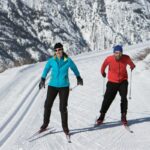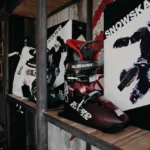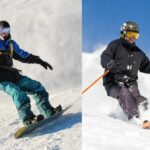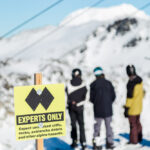A well-structured training plan for cross-country skiing in the summer is key to making measurable progress and avoiding overtraining!
Understanding Cross-Country Skiing Fundamentals
Cross-country skiing is a demanding sport that combines endurance and technique. Fundamentally, it involves traversing across varied snowy terrains using skis and poles. This sport has two primary styles: the classic technique and skating. The classic technique resembles a striding motion along parallel tracks, while the skating technique is akin to ice skating, pushing off with the edge of the ski.
For cross-country skiers, efficiency in movement is crucial. This requires a well-honed ski technique that minimizes energy wastage. Core strength plays a pivotal role, as it helps maintain balance and form. Additionally, powerful leg muscles contribute to muscular endurance, critical for both the explosive power in skating and the sustained force needed in the classic technique.
A skier must possess:
- Physical endurance: For long-distance skiing.
- Muscular endurance: To tire less easily and maintain form.
- Balance: For efficient control over uneven terrain.
- Technique: To maximize glide and minimize effort.
Improving these elements in the offseason can lead to considerable performance gains. Summer training should, therefore, focus on activities that develop these fundamental aspects. Skiers engage in a range of exercises, from Nordic walking to simulate the cross-country skiing motion, to strength training to build core and leg muscles. For endurance, activities like running, biking, or roller skiing are often incorporated into their regimes.
Understanding and mastering these fundamentals lays the groundwork for a successful cross-country skiing experience, whether one is a beginner or an advanced skier.
Developing a Structured Training Plan

A well-structured training plan for cross-country skiing in the summer is key to making measurable progress and avoiding overtraining. This plan should align with personal goals, be consistent, and appropriately balance workouts with rest days.
Setting Goals
They start by identifying precise, achievable goals. Whether it’s to improve endurance, enhance technique, or increase strength, objectives should be SMART: Specific, Measurable, Achievable, Relevant, and Time-bound. A skier aiming to enhance their technique might set a goal to master a specific skill by the end of summer.
Designing Your Training Routine
Designing a routine requires a thoughtful approach. A typical training week might include a mix of roller skiing, strength training, and endurance workouts. For instance, one might schedule strength training exercises for cross-country skiing twice a week focusing on core, upper, and lower body—enough to improve muscle endurance without excessive bulk. Aerobic activities could be planned for three days including one longer session to build endurance, and technique drills might be incorporated twice weekly to sharpen skills.
Incorporating Rest Days
Rest days are a critical component of any training plan. They incorporate at least one to two days of rest into their weekly schedule to prevent overtraining and facilitate recovery. During the off-season, they emphasize that rest days don’t necessarily mean complete inactivity. Activities like light yoga or stretching can help maintain flexibility and aid in recovery while still allowing muscles to rest.
Building Endurance and Cardiovascular Fitness

To excel in cross-country skiing, athletes focus on building cardiovascular fitness and endurance during the off-season. Activities that raise the heart rate and challenge both the aerobic and anaerobic systems are integral to a well-rounded summer training program.
Running and Trail Running
Running is a staple in cross-country ski training, providing a solid aerobic base crucial for endurance. Athletes often incorporate trail running to mimic the varied terrain of ski courses, enhancing their stability and agility. A mix of distances and paces sharpens both speed and endurance, preparing them for the demands of the winter season.
Biking and Roller Skiing
Biking offers an effective low-impact workout, aiding in cardiovascular fitness without the stress on joints that running entails. Roller skiing stands out as the closest summer activity to on-snow skiing, working on specific muscle groups and technique. Frequent roller ski sessions contribute to muscle memory and ensure a smooth transition back to snow.
Swimming
Swimming is incorporated by cross-country skiers as a full-body workout that promotes cardiovascular health. The resistance of water offers a unique endurance challenge while also providing excellent recovery for sore or fatigued muscles from other forms of training.
Enhancing Strength and Muscle Conditioning

In summer cross-country skiing preparation, athletes focus on building muscle strength and conditioning to improve performance. Targeted gym exercises and outdoor drills play a crucial role in developing the necessary muscle groups for skiing efficiency.
Gym-Based Strength Training
Gym routines for cross-country skiers should prioritize compound movements to train multiple muscle groups simultaneously. A typical strength training session might include:
- Squats: 3 sets of 12 repetitions to strengthen the quads, hamstrings, and glutes.
- Deadlifts: 3 sets of 10 repetitions to engage the lower back, hamstrings, and glutes.
- Leg Press: To target the quads and calves, athletes often perform 3 sets of 15 repetitions.
Incorporating gym equipment, such as leg extension and hamstring curl machines, can isolate specific leg muscles, further enhancing leg strength crucial for skiing.
Core and Upper Body Workouts
Strengthening an athlete’s core and upper body is essential for stability and power during cross-country skiing. Effective workouts include:
- Pull-ups: Aim for 2 sets of 6-8 repetitions to fortify the lats and biceps.
- Push-ups: 2-3 sets of 10-15 repetitions to work the chest, shoulders, and triceps.
- Planks: Holding for 1-2 minutes to engage and strengthen the entire core.
Exercises such as the Russian twist are also recommended to develop rotational strength, which is beneficial for skiing movements.
Plyometrics and Agility Drills
For explosive strength and agility, plyometric exercises are integrated into the training regimen:
- Box Jumps: Perform 3 sets of 10 jumps to boost explosive leg power.
- Lateral Bounds: These target the abductors and adductors, with athletes aiming for 2-3 sets of 8-12 bounds on each side.
- Skater Jumps: For lateral movement and coordination, complete 2 sets of 15 jumps each side, mimicking the skiing motion.
Such drills enhance athletes’ ability to quickly change directions and improve neuromuscular coordination, directly translating to more agile skiing.
Improving Ski-Specific Techniques
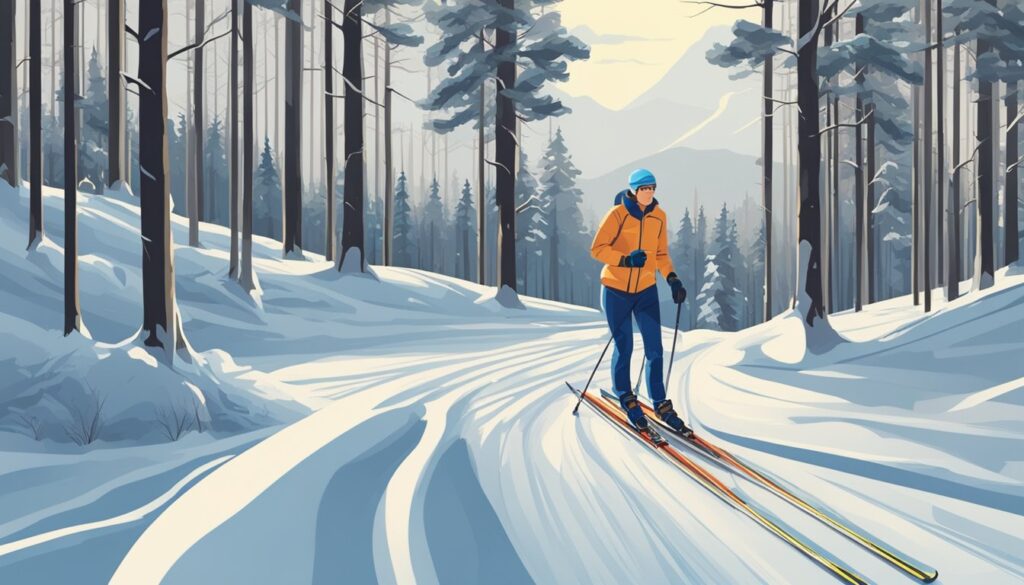
To maintain and improve cross-country skiing proficiency during the summer, athletes focus on mimicking on-snow movements and developing ski-specific muscle groups. This can involve a combination of roller skis, dryland training exercises, and specialised equipment such as ski machines and nordic walking.
Role of Roller Skis
Roller skis are critical for summer training, offering a near-authentic skiing experience. They help skiers develop technique and muscle memory, especially for the fundamental motion of double poling. On roller skis, athletes can work on balance, coordination, and the specific timing required for efficient skiing, reflecting the precise nuances of winter skiing.
Dryland Training Exercises
Dryland training exercises are a suite of activities designed to strengthen muscles and improve techniques specific to cross-country skiing. Core exercises such as planks and leg blasters augment an athlete’s ability to maintain stable posture and control. Exercises like box jumps and lunges focus on leg strength and power, which are essential for effective kick and glide techniques. For upper body strengthening, skiers engage in pull-ups and push-ups, enhancing the muscles vital for skiing like those used in double poling.
Use of Ski Machines and Nordic Walking
Ski machines provide a low-impact workout that targets the same groups of muscles used in cross-country skiing. They offer adjustable resistance and simulate the skiing motion, allowing for intensity modifications akin to skiing up different inclines.
Nordic walking, involving the use of poles similar to those used in skiing, also serves as an excellent alternative for training. It engages the upper body, mimics the arm action of skiing, and can improve cardiovascular health and endurance.
Prevention and Management of Injuries
Cross-country skiing athletes can face various injuries, but with the right approach, they can manage these risks effectively. By understanding common injuries, employing prevention strategies, and using recovery techniques, skiers can maintain their body’s health and ensure consistent performance.
Understanding Common Injuries
Injuries in cross-country skiing generally affect the lower limbs, knees, shoulders, and back. Overuse injuries can result from the repetitive motions of skiing, while acute injuries might occur from falls or sudden stress. Strains, sprains, and stress fractures are not uncommon. Access to information about the nature and frequency of these injuries can be found in a detailed analysis published in the Clinical Journal of Sport Medicine.
Injury Prevention Strategies
Consistent Training: Gradually increasing training intensity allows the body to adapt, reducing the risk of overuse injuries.
- Strength Training: Incorporate exercises like pull-ups and push-ups to build upper body strength, complemented by lower-body workouts.
- Flexibility and Balance: Engage in activities like yoga to promote flexibility and balance, crucial for injury prevention.
- Proper Equipment: Use well-fitted boots and skis to avoid unnecessary strain.
Recovery Techniques
Physical Rest and Nutrition: Allow the body adequate time to heal after rigorous sessions, complemented by a balanced diet to support recovery.
- Rest: Prioritize rest days and ensure sufficient sleep for maximum recovery.
- Active Recovery: Incorporate low-intensity activities such as Nordic walking to aid muscle recovery.
- Physical Therapy: Seek professional guidance when dealing with persistent pain or injuries.
Cross-Training for Comprehensive Fitness
Cross-training is an essential component of off-season training for cross-country skiers. It focuses on improving overall fitness, preventing injury, and breaking the monotony of traditional ski-training routines. The ideal cross-training regimen includes a mix of aerobic and anaerobic exercises, targeting various muscle groups to ensure a full-body workout.
Incorporating Biking and Swimming
Biking provides excellent aerobic exercise, helping skiers maintain and improve their cardiovascular endurance. It recruits different muscles than skiing, such as the quadriceps, which contributes to a comprehensive leg workout. Cross-country skiers can integrate interval training on the bike to simulate the intensity of skiing. For swimming, it’s a low-impact activity that engages the core and upper body, promoting muscular endurance and flexibility. Skiers benefit from the resistance of the water, making it an effective full-body workout that minimizes strain on the joints.
Yoga and Stretching
Regular yoga sessions can be instrumental for cross-country skiers. They enhance flexibility, balance, and core strength, all of which are crucial for the dynamic movements in skiing. Yoga poses like the Warrior series and Downward Dog focus on the legs, hips, and spine, which are areas highly utilized during skiing. Additionally, incorporating stretching into the routine can prevent injuries and aid in muscle recovery after strenuous workouts.
Strength and Balance Workouts
Focused strength and balance workouts are vital in cross-training. Skiers benefit greatly from exercises like lunges, squats, and plyometrics that mimic the skiing motion and build explosive power. Balance can be trained using tools such as Bosu balls or balance boards, which improve proprioception and stability — key factors in managing challenging terrains and skiing techniques. For the upper body, exercises using resistance bands or pull-ups help maintain ski-ready muscle groups.
Nutrition and Lifestyle for Peak Performance
Training for cross-country skiing in the summer demands a strategic approach to nutrition and lifestyle. To reach peak performance, athletes must focus on consuming a balanced diet, staying hydrated, ensuring adequate sleep and recovery, and preparing mentally for the challenges ahead.
Balanced Diet and Hydration
A balanced diet is pivotal, comprising of carbohydrates for energy, proteins for muscle repair, and fats for hormone functions. For cross-country skiers, carbohydrates should be the main fuel, especially given the endurance nature of the sport. Skiable workouts suggest that athletes need a mix of simple and complex carbohydrates to maintain energy levels. Hydration is equally critical; skiers should monitor their water intake to prevent dehydration, which can significantly impair performance. The US Cross-Country Ski Team coach mentions that an adequate mix of fluids and electrolytes is essential to maintain muscle function and concentration during long training sessions.
Sleep and Recovery
Quality sleep cannot be overstated; it is as crucial as training itself. Athletes should aim for 7-9 hours of restorative sleep each night to enable muscle recovery and cognitive function. Integrating rest days into a training regimen allows the body to repair and adapt to the stress of exercise. Regular, moderate, summer cross-country ski-related activities such as Nordic walking are encouraged on rest days to promote active recovery and maintain fitness levels.
Mental Preparation
Mental preparation rounds out the holistic approach to training. Athletes need to develop a resilient mindset to handle both the physical and psychological demands of the sport. Techniques such as visualization and goal setting can help in fostering focus and motivation. It’s advised that mental exercises be incorporated into daily routines, as they are effective in building the mental toughness required for the rigors of cross-country skiing competitions.
Gear and Equipment Maintenance
Proper maintenance of cross-country skiing equipment ensures both performance and longevity. The summer months provide ample time to assess and maintain gear, from skis and poles to boots and protective wear.
Selecting the Right Equipment
When choosing equipment for cross-country skiing, one must consider summer training tools such as roller skis. Roller skis are essential for simulating the skiing experience on pavement. It’s crucial to select a pair that matches one’s skill level and training conditions. Proper boots that fit the binding system of the roller skis are also pivotal for a secure and comfortable experience.
Summer Maintenance of Winter Gear
During the off-season, skis require thorough cleaning to remove old wax, followed by the application of a storage wax to protect the bases from dirt and oxidation. It is paramount for individuals to inspect poles for any damage and replace baskets or tips as needed. Boots should be cleaned, dried, and stored in a cool, dry place, with special attention given to preserving the integrity of the sole and the lacing system.
Safety and Protective Gear
The summer sun demands the use of protective gear such as sunglasses and broad-spectrum sunscreen to shield against harmful UV rays. Athletes should also wear appropriate clothing that provides ventilation and moisture-wicking properties to maintain comfort during training. Additionally, using helmets and knee pads while roller skiing can prevent injuries from falls on hard surfaces.
Learning from Experts
To excel in cross-country skiing, leveraging the expertise of seasoned professionals is invaluable. They provide targeted training tips, skill-enhancement strategies, and can tailor programs to both beginner and veteran skiers aiming for peak performance in a cross-country ski race.
Working with a Coach or Trainer
Working with a personal trainer or coach offers personalized guidance to optimize one’s summer training regimen. They assess individual strengths and weaknesses, creating a balanced workout plan that focuses on core stability, endurance, and the specific muscle groups used in cross-country skiing. Kevin Shields, with his extensive coaching background, emphasizes the benefit of a tailored approach for cross-country skiers.
Lessons and Clinics
Participation in lessons and clinics is important for those new to the sport and those refining their skills. Clinics, often led by professionals, can aid skiers in understanding the mechanics of skiing and offer practical training tips. Worldloppet’s professional summer training resource highlights the importance of incorporating strength and speed into one’s summer training.
Reading and Research
Finally, dedicated reading and research can provide a wealth of knowledge. Engaging with well-established training guides, like those found on Nordicstrong, encourages cross-country skiers to incorporate exercises for muscular endurance into their weekly routine. Moreover, continuous learning helps skiers stay updated on the current best practices in cross-country ski training.
Participation in Summer Competitions
Participating in summer competitions provides cross-country skiers with a valuable opportunity to test their skills, measure progress, and stay motivated. These events can be critical stepping stones leading to major winter races such as the Vasaloppet.
Finding Local Races and Events
Cross-country skiers looking to compete in the off-season should begin by researching local races and events. Many regions offer summer ski races on roller skis or host biathlon competitions that complement cross-country training. Athletes can consult with their coaches, join local ski clubs, or check online event calendars to find suitable competitions.
Competition Preparation
Preparation is key for any athlete aiming to excel in a summer cross-country ski race. This involves not only maintaining a rigorous training regimen but also becoming familiar with the specifics of the event. Competitors should focus on tailored workouts that replicate race conditions, and they should also make sure that their equipment, such as roller skis, is in top condition for the event.
Post-Race Analysis
After a competition, it is essential for skiers to engage in post-race analysis. With the help of a coach, athletes should review their performance, identifying strengths and areas for improvement. This feedback is invaluable and can inform future training plans, ensuring that the skier continues to make progress throughout the summer months.
Adapting to Summer Weather Conditions
Training for cross-country skiing during summer involves navigating the challenges presented by warmer weather. Athletes must adapt their routines to ensure they continue to build their skiing fitness while staying healthy and safe.
Training in Warm Temperatures
In summer, athletes should adjust their training times to the cooler hours of early morning or evening to avoid the most intense heat. Layering appropriate clothing is crucial; they should opt for breathable, moisture-wicking fabrics that facilitate better air circulation and help regulate body temperature. Adding interval training with short bursts of high-intensity exercise can also be effective in building endurance while minimizing prolonged exposure to heat.
Staying Hydrated
Hydration is key in summer training as it ensures the body functions effectively and helps prevent heat-related illnesses. Athletes must drink water consistently throughout the day, not just during workouts. They should carry a water bottle and consider using hydration packs during longer training sessions. A general guideline is to drink at least 7-10 ounces of water every 10-20 minutes of exercise, adjusting for sweat loss and air temperature.
Protecting Skin and Eyes
Sun exposure increases in summer, so applying broad-spectrum sunscreen which offers both UVA and UVB protection is essential, as is reapplication after sweating or swimming. Wearing sunglasses to protect the eyes from harmful UV rays is also necessary. The sunglasses should have UV protection and wrap-around features to shield eyes from the sun’s reflection off surfaces like pavement, which can be particularly intense during long training sessions.
- Types of Skiing Terrains: A Comprehensive Guide for Every Skier - December 6, 2024
- Skiing Nutrition: Essential Nutritional Advice and Meal Planning for Skiers - August 15, 2024
- Backcountry Skiing Explained: Essential Tips and Gear - August 8, 2024

